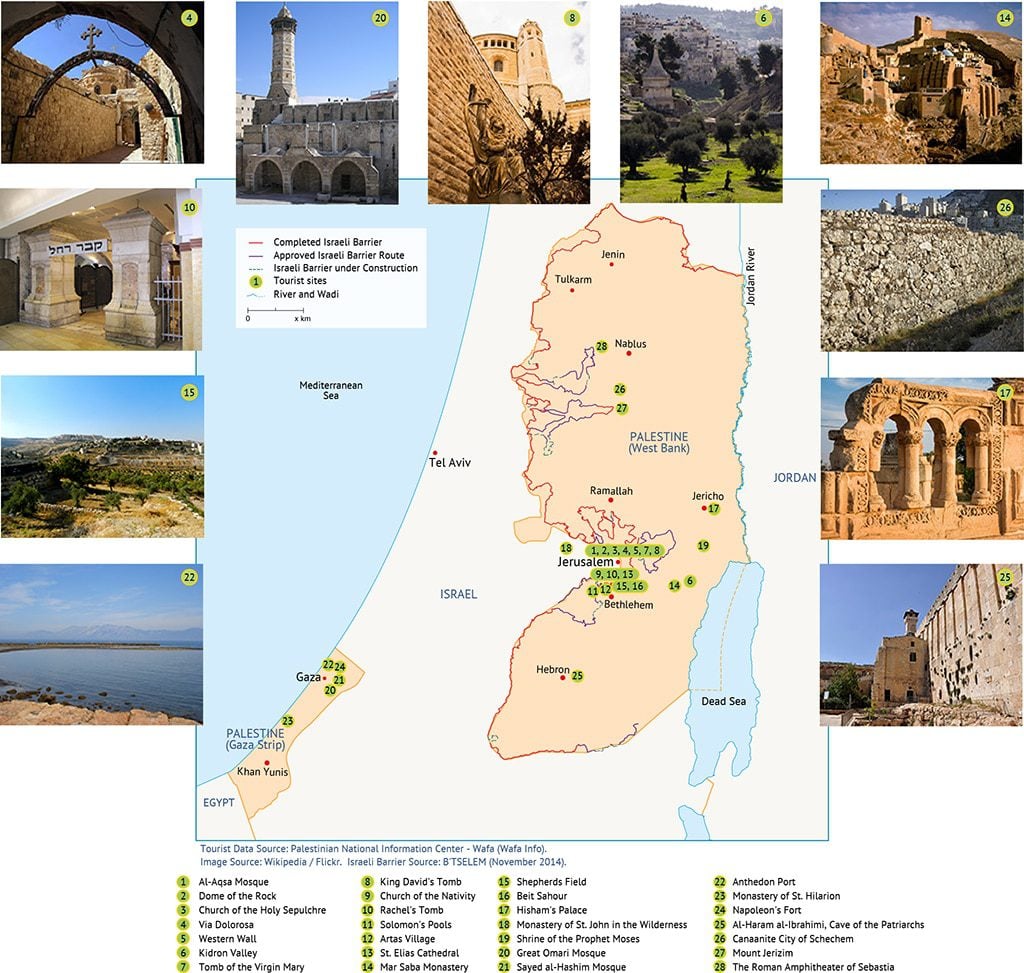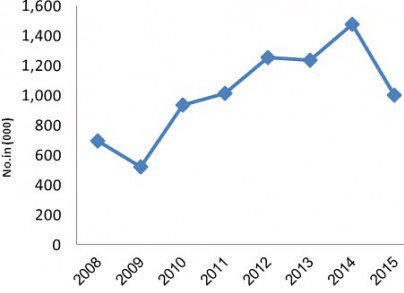
Despite the fact that Palestine is not an independent state with control over its own borders, the Palestinian territories (East Jerusalem, the West Bank and the Gaza Strip) nevertheless attract a significant number of tourists every year to its unique religious and historical sites.
Palestine has hosted many powers and peoples over the millennia such as the Canaanites, Babylonians, Assyrians, ancient Greeks, Phoenicians, Romans, Byzantines, Crusaders and Ottomans. Their legacy lives on in a rich collection of antiquities and archaeological finds as well as cities that are tourist attractions in themselves. The warm weather in the summer and relatively mild climate in the winter have helped Palestine to become a destination for tourists of different tastes and races. Its diverse landscape encompasses Mediterranean beaches; the salty Dead Sea – the lowest point on earth; snow-capped mountains, wide plains and arid deserts. Palestine is also home to Jericho, the world’s oldest continuously inhabited settlement.
Tourism in Palestine can be divided into several types. First and foremost is religious tourism thanks to the concentration of sites revered by the followers of the three great monotheistic faiths (Islam, Judaism and Christianity). The second is cultural tourism due to the wealth of archaeological attractions. The third is therapeutic or health tourism based on the benefits of the Dead Sea.
Palestine is the home of the holiest churches for Christians: the Church of the Nativity in Bethlehem and the Church of the Holy Sepulchre in Jerusalem. In Jerusalem is al-Aqsa, Islam’s third holiest mosque and the gilded Dome of the Rock, a Muslim shrine. Al-Aqsa Mosque is located on the Temple Mount, which is the holiest site in Judaism. At the foot of it is the Western Wall – also known as the Wailing Wall – the holiest place where Jews are permitted to pray.
Current Status of Tourism in Palestine
The religious, archaeological and natural attractions mentioned above have boosted the economic and cultural standing of the Palestinian territories as well as Palestinian identity. The black and white keffiyeh (scarf), for instance, has been a global symbol of Palestinian heritage and identity for decades.
Despite the hard work by the Palestinian Authority (PA) to strengthen the tourism sector, including efforts by the Ministry of Tourism and Antiquities to attract visitors from Latin America, Russia and Europe, tourist numbers declined sharply in the second half of 2015 following an encouraging start in the first half of the year. This was primarily due to the violence that erupted in East Jerusalem and the West Bank at the beginning of October.
A report published by Palestinian media showed a drop in foreign visitors by approximately 11% to 2.23 million, compared to almost 2.53 million in 2014. This was itself a decline over previous years due to the Israel-Gaza conflict that extended through the summer.

In a statement issued by the Palestinian Ministry of Tourism, Minister of Tourism and Antiquities Rola Ma’ayi’ah said that “the incidents taking place in Palestine have led to a decline in the number of tourists visiting us to fewer than 2.5 million, which is a small number compared to 2014”.
Large numbers of tourists were expected, especially after many European countries lifted the travel ban that had been imposed on citizens following the 2014 conflict, but the incidents in the West Bank and Jerusalem caused many bookings to be cancelled or postponed.
The decrease in the number of visitors has been accompanied by a sharp drop in overnight stays. In 2015, some 981,315 tourists stayed overnight in hotels in the Palestinian territories, compared to 1,211,561 the previous year.
From an economic perspective, the high costs of running a hotel, notably employee wages, are unsustainable if occupancy rates are low. These figures show the extent of the losses sustained by the tourism sector, which amounted to approximately 15% of Palestinian GDP.
Obstacles to the Development of Tourism
Tourism is an important but underexploited contributor to Palestinian GDP. Since the establishment of the Palestinian National Authority (PNA) in 1994, more attention has been given to the sector, with the Ministry of Tourism and Antiquities dedicated to promoting tourism and maintaining archeological sites.
However, Israel has sought to discourage foreign tourists from visiting the Palestinian territories by introducing deterrents such as lengthy questioning upon arrival and departure. Additionally, Israeli tourist companies have set conditions for groups visiting the Holy Land, one of them being that accommodation should be in Israeli hotels.
All of this is possible because of Israeli control over airspace – Tel Aviv’s Ben Gurion Airport is the only flight arrival point – and border crossings with its neighbours. This highly affects the development of the tourism sector and results in constant fluctuations in visitor numbers and income.
Palestine has officially become a member of the World Tourism Organization, as announced during the International Conference on Religious Tourism held on 15 June 2015 in Bethlehem and attended by political figures from around the world. The PA has campaigned for membership since Palestine was recognized as ‘a non-member observer state in the UN’ at the end of 2012, in the hope that membership would enable it to overcome the obstacles impeding the growth and development of the tourism sector.
Aside from the political and security constraints, tourist infrastructure is weak in terms of the availability of facilities such as hotels and restaurants. The upkeep of attractions and cities is also insufficient, discouraging longer stays, combined with a shortage of qualified personnel. The situation is exacerbated by poor international marketing of Palestine as a tourist destination, and a clear lack of awareness among citizens of the importance of tourism. The dominance of Israeli tourist companies also makes it difficult to compete. All of these factors affect the quality of Palestine’s tourism offering and indicate that there is a lot to be done to develop the sector.

